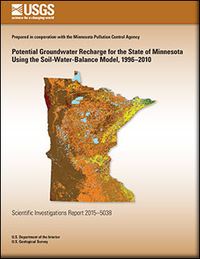Potential groundwater recharge for the State of Minnesota using the Soil-Water-Balance model, 1996-2010
Links
- More information: USGS Index Page
- Document: Report (5.23 MB pdf)
- Download citation as: RIS | Dublin Core
Abstract
Groundwater recharge is one of the most difficult components of a water budget to ascertain, yet is an important boundary condition necessary for the quantification of water resources. In Minnesota, improved estimates of recharge are necessary because approximately 75 percent of drinking water and 90 percent of agricultural irrigation water in Minnesota are supplied from groundwater. The water that is withdrawn must be supplied by some combination of (1) increased recharge, (2) decreased discharge to streams, lakes, and other surface-water bodies, and (3) removal of water that was stored in the system. Recent pressure on groundwater resources has highlighted the need to provide more accurate recharge estimates for various tools that can assess the sustainability of long-term water use. As part of this effort, the U.S. Geological Survey, in cooperation with the Minnesota Pollution Control Agency, used the Soil-Water-Balance model to calculate gridded estimates of potential groundwater recharge across Minnesota for 1996‒2010 at a 1-kilometer (0.621-mile) resolution. The potential groundwater recharge estimates calculated for Minnesota from the Soil-Water Balance model included gridded values (1-kilometer resolution) of annual mean estimates (that is, the means for individual years from 1996 through 2010) and mean annual estimates (that is, the mean for the 15-year period 1996−2010).
The Soil-Water-Balance model uses a modified Thornthwaite-Mather soil-water-balance approach, with components of the soil-water balance calculated on a daily basis. A key advantage of this approach includes the use of commonly available geographic information system data layers that incorporate land cover, soil properties, and daily meteorological data to produce temporally and spatially variable gridded estimates of potential recharge. The Soil-Water-Balance model was calibrated by using a combination of parameter estimation techniques, making manual adjustments of model parameters, and using parameter values from previously published Soil-Water-Balance models. Each calibration simulation compared the potential recharge estimate from the model against base-flow estimates derived from three separate hydrograph separation techniques. A total of 35 Minnesota watersheds were selected for the model calibration.
Meteorological data necessary for the model included daily precipitation, minimum daily temperature, and maximum daily temperature. All of the meteorological data were provided by the Daymet dataset, which included daily continuous surfaces of key climatological data. Land-cover data were provided by the 2001 and 2006 National Land Cover Database: the 2001 classification was used from 1994 through 2003, and the 2006 classification was used from 2004 through 2010. Soil data used in the model included hydrologic soils group and the available soil-water capacity. These soil data were obtained from the Natural Resources Conservation Service Soil Survey Geographic (SSURGO) database and the State Soil Geographic (STATSGO) database.
The statewide mean annual potential recharge rate from 1996–2010 was 4.9 inches per year. Potential recharge estimates increased from west to east across Minnesota. The mean annual potential recharge estimates across Minnesota at a 1-km resolution for the overall simulation period (1996–2010) ranged from less than 0.1 to 17.8 inches per year. Some of the lowest potential recharge rates for the simulation period were in the Red River of the North Basin of northwestern Minnesota, and generally were between 1.0 and 1.5 inches per year. The highest potential recharge rates were in northeastern Minnesota and the Anoka Sand Plain in central Minnesota. Eighty-eight percent of the potential recharge rates (by grid cell) were between 2 and 8 inches per year from 1996–2010. Only about 3 percent of all the potential recharge estimates (by grid cell) were less than 2 inches per year, and 9 percent of estimates were greater than 8 inches per year.
On an annual basis, however, potential recharge rates were as high as 27.2 inches per year. The highest annual mean recharge estimate across the State was for 2010, and the lowest mean recharge estimate was for 2003. Although precipitation variability partially explained the annual differences in potential recharge estimates, precipitation alone did not account for these differences, and other factors such as antecedent moisture conditions likely were important. Also, because precipitation gradients across the State can vary from year to year, the dominant land-cover class and hydrologic soil group combinations for a particular region had a large effect on the resulting potential recharge value. During 1996–2010, April had the greatest monthly mean potential recharge compared to all other months, accounting for a mean of 30 percent of annual potential recharge in this single month.
Study Area
| Publication type | Report |
|---|---|
| Publication Subtype | USGS Numbered Series |
| Title | Potential groundwater recharge for the State of Minnesota using the Soil-Water-Balance model, 1996-2010 |
| Series title | Scientific Investigations Report |
| Series number | 2015-5038 |
| DOI | 10.3133/sir20155038 |
| Year Published | 2015 |
| Language | English |
| Publisher | U.S. Geological Survey |
| Publisher location | Reston, VA |
| Contributing office(s) | Minnesota Water Science Center |
| Description | vii, 85 p. |
| First page | 85 |
| Time Range Start | 1996-01-01 |
| Time Range End | 2010-12-31 |
| Country | United States |
| State | Minnesota |
| Datum | North American Datum of 1983 |
| Projection | Universal Transverse Mercator projection, Zone 15 North |
| Online Only (Y/N) | Y |
| Additional Online Files (Y/N) | N |


